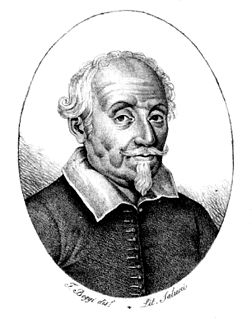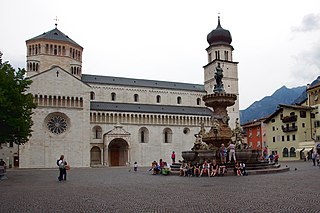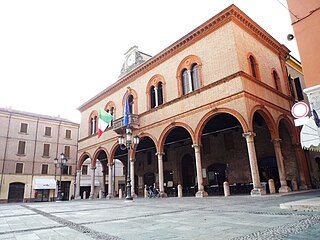The Torre della Ghirlandina or simply Ghirlandina is the bell tower of the Cathedral of Modena, in Emilia-Romagna, Italy.
Standing at 86.12 metres, the tower is the traditional symbol of Modena, being visible from all directions outside the city.
The structure was set up in 1179 on five floors, initially called Torre di San Geminiano. To compete with Bologna's towers, the Comune added the characteristic octagonal cusp, designed by Arrigo da Campione, one of the numerous masters from Campione who took part in the cathedral's renovation in the 13th-15th centuries. The top of the tower is decorated with two ghirlande (two marble railings), whence the name.
In the interior, the Sala della Secchia room (with 15th-century frescoes) is home of a copy of the depiction of the Secchia rapita, a memory of the tower's former role as treasury of the Modenese Comune. Also notable are the sculpted capitals in the Sala dei Torresani hall, in the fifth floor. The five bells are tuned in C major, cast during the Renaissance period. It also has a stand for the oaken bucket from the War of the Bucket.

The Leaning Tower of Pisa, or simply the Tower of Pisa, is the campanile, or freestanding bell tower, of the cathedral of the Italian city of Pisa, known worldwide for its nearly four-degree lean, the result of an unstable foundation. The tower is situated behind the Pisa Cathedral and is the third-oldest structure in the city's Cathedral Square, after the cathedral and the Pisa Baptistry.

Modena is a city and comune (municipality) on the south side of the Po Valley, in the Province of Modena in the Emilia-Romagna region of northern Italy.

Arezzo is a city and comune in Italy and the capital of the province of the same name located in Tuscany. Arezzo is about 80 kilometres southeast of Florence at an elevation of 296 metres (971 ft) above sea level. In 2013 the population was about 99,000.

The Comacine masters were early medieval Lombard stonemasons working in a region of excellent building stone who gave to Lombardy its preeminence in the stone architecture that preceded Romanesque style.

The Piazza dei Miracoli, formally known as Piazza del Duomo, is a walled 8.87-hectare area located in Pisa, Tuscany, Italy, recognized as an important centre of European medieval art and one of the finest architectural complexes in the world. Considered sacred by the Catholic Church, its owner, the square is dominated by four great religious edifices: the Pisa Cathedral, the Pisa Baptistry, the Campanile, and the Camposanto Monumentale. Partly paved and partly grassed, the Piazza dei Miracoli is also the site of the Ospedale Nuovo di Santo Spirito, which houses the Sinopias Museum and the Cathedral Museum.

Fano[ˈfaːno] is a town and comune of the province of Pesaro and Urbino in the Marche region of Italy. It is a beach resort 12 kilometres southeast of Pesaro, located where the Via Flaminia reaches the Adriatic Sea. It is the third city in the region by population after Ancona and Pesaro.

Alessandro Tassoni was an Italian poet and writer.

The province of Chieti is a province in the Abruzzo region of Italy. Its provincial capital is the city Chieti, which has a population of 50,770 inhabitants. The province has a total population of 387,649 inhabitants as of 2017 and spans an area of 2,599.58 square kilometres (1,003.70 sq mi). It is divided into 104 comuni (comune) and the provincial president is Mario Pupillo.

The Castello Sforzesco is a medieval fortification located in Milan, northern Italy. It was built in the 15th century by Francesco Sforza, Duke of Milan, on the remnants of a 14th-century fortification. Later renovated and enlarged, in the 16th and 17th centuries it was one of the largest citadels in Europe. Extensively rebuilt by Luca Beltrami in 1891–1905, it now houses several of the city's museums and art collections.

Lanciano is a town and comune in the province of Chieti, part of the Abruzzo region of central Italy. It has 36,304 inhabitants as of 2011. The town is known for the first recorded Catholic Eucharistic Miracle. Lanciano is located about 10 kilometres (6.2 mi) from the Adriatic Sea in an elevated spot.
Torre means tower in seven Romance languages and may refer to:
The Battle of Zappolino, the only battle of the War of the Oaken Bucket, was fought in November 1325 between forces representing the Italian towns of Bologna and Modena, an incident in the series of raids and reprisals between the two cities that were part of the larger conflicts of Guelphs and Ghibellines. The Modenese were victorious. Though many clashes between Guelphs and Ghibellines loomed larger to contemporaries than to historians, the unusually-large encounter involved 4000 estimated cavalry and some 35,000 foot soldiers, and 2000 men lost their lives. The location of the battle, at the foot of a hill just outside the castle walls, is now a frazione of the municipality of Castello di Serravalle, Emilia-Romagna.

Modena Cathedral is a Roman Catholic cathedral in Modena, Italy, dedicated to the Assumption of the Virgin Mary and Saint Geminianus. Formerly the seat of the Diocese, later Archdiocese, of Modena, it has been since 1986 the archiepiscopal seat of the Archdiocese of Modena-Nonantola. Consecrated in 1184, it is an important Romanesque building in Europe, and along with its bell tower, the Torre della Ghirlandina, is designated as a World Heritage Site.

Modugno is a town and comune of the Metropolitan City of Bari, Apulia, southern Italy.

La Secchia Rapita is a mock-heroic epic poem by Alessandro Tassoni, first published in 1622. Later successful mock-heroic works in French and English were written on the same plan.

Trento Cathedral is a Roman Catholic cathedral in Trento, northern Italy. It is the mother church of the Roman Catholic Archdiocese of Trento, and until 1802, was the seat of the Bishopric of Trent. It was built over a pre-existing 4th-century church devoted to Saint Vigilius, patron saint of the city.

Ferrara Cathedral is a Roman Catholic cathedral and minor basilica in Ferrara, Northern Italy. Dedicated to Saint George, the patron saint of the city, it is the seat of the Archbishop of Ferrara and the largest religious building in the city.

The Palazzo Comunale, also known as the Palazzo del Popolo of San Gimignano has been the seat of the civic authority in the comune since the 13th century. It is located on the Piazza del Duomo close to the Collegiate Church of the Assumption of the Blessed Virgin Mary. The building and Collegiate Church are at the heart of the medieval town, and are part of the UNESCO World Heritage Site of the "Historic Centre of San Gimignano".

The War of the Bucket or the War of the Oaken Bucket was fought in 1325 between the rival city-states of Bologna and Modena. It took place in the region of Emilia-Romagna, in northern Italy. The war was an episode in the over 300-year-long struggle between Guelphs and Ghibellines. Modena won the Battle of Zappolino, the only battle of the war.

The Town hall of Mirandola is a historic public building located in the city center of Mirandola, in the province of Modena, Italy.





















